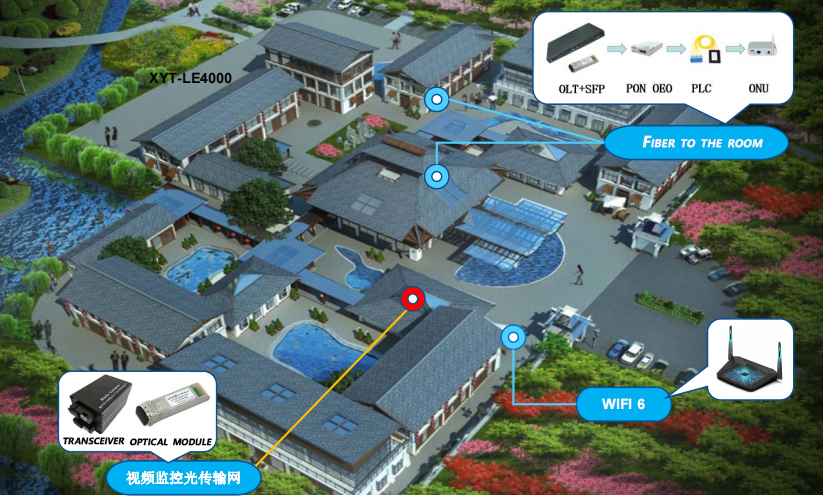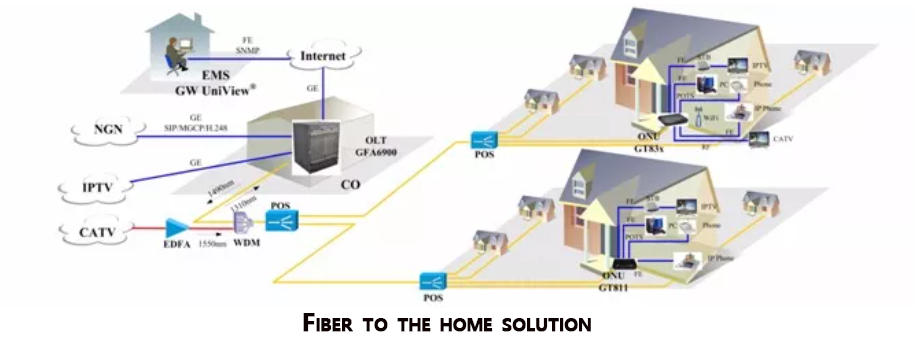Passive optical network (#PON#) is an optical fiber network that uses point-to-multipoint topology and optical splitters to transmit data from a single transmission point to multiple user endpoints. In this context, passive refers to the unpowered state of fiber optics and split/combined components. Compared with active optical networks, electricity is only required at the sending and receiving points, which makes PON inherently efficient from the point of view of operating costs. Passive optical networks are used to simultaneously transmit signals to and from user endpoints in the upstream and downstream directions.

Optical fiber and splitter are true "passive" components of PON and do not require power supply. The optical splitter is not wavelength selective, but only splits any optical wavelength in the downstream direction. Of course, the splitting of the optical signal will cause power loss, which depends on the number of signal splitting methods. Splitters do not require the inherent cooling or other ongoing maintenance of active network components (such as optical amplifiers) and can last for decades if they are not disturbed. In addition to passive components, the complete creation of a PON network also requires active terminal equipment. Optical Line Terminal (OLT) is the starting point of passive optical networks. It is connected to the core switch via an Ethernet pluggable device. The main function of the OLT is to convert, frame and transmit the signals of the PON network, and coordinate the multiplexing of the optical network terminal (ONT) to achieve shared upstream transmission. You can also see the end-user equipment called Optical Network Unit (ONU). This is just the difference in terminology between the two main standards bodies (ITU-T using ONT and IEEE using ONU). These two terms actually They are interchangeable, but depend on the PON service and standard used.

Passive optical network architecture
The PON network adopts a point-to-multipoint (P2MP) structure, and uses an optical splitter to divide the downstream signal from a single OLT into multiple downstream paths to the end user. The same splitter will return multiple paths from the end user to the OLT. The upstream paths are grouped together. The point-to-multipoint optical access network has the inherent efficiency of optical fiber sharing and low power consumption, and was selected as the most feasible passive optical network architecture. This architecture was standardized in 1998 through the ATM-PON G.983.1 specification. Today, because asynchronous transfer mode (ATM) is no longer used, the ITU-T G.984 standard for G-PON has replaced the ATM standard. A PON network starts with an optical line terminal (OLT) located at the source of the service provider, usually called a local or central office, and sometimes called a switch or head end. From there, the fiber-optic feeder cable (or feeder fiber) is routed to the passive splitter, and spare fiber (if used). Then, the distribution fiber is connected from the splitter to the lead-in terminal. The lead-in terminal can be located in a street cabinet or in a reinforced enclosure installed in a pit, on a pole or even on the side of a building. Then, the incoming optical fiber provides the final one-to-one connection from the incoming terminal port to the end user ONT/ONU. In some cases, multiple splitters are used in series, which is called a cascaded splitter architecture.

The signal carried on the feeder fiber can be split to provide services to up to 256 users, among which ONUs or ONTs convert the signals and provide users with Internet access. The number of ways in which the downstream OLT signal is divided or split before reaching the end user is called the splitter or split ratio (for example, 1:32 or 1:64).
In a more complex configuration, where RF video and PON data services are broadcast in parallel, or additional PON services coexist on the same PON network, passive (MUX) combiners are used in the central/local office to cover the wavelength and additional The wavelength of the PON service is merged onto the outbound OLT feeder fiber.
Sharetop Technology can provide a full range of optical transmission products for the construction of a unified management video surveillance optical transmission network, fiber-to-the-building & fiber-to-the-home, community 4/5G small base station construction, and full coverage fiber optic network system.

隐私保护 |
法律声明 |
在线留言 |
网站导航 |
网站地图 |
文档下载 | 咨询热线:0755-27524036 |
订阅
深圳纤亿通科技有限公司版权所有 转载必究 Copyright 2010-2019 poptimes CO.,Ltd. All rights reserved.
备案号:粤ICP备14020946号
友情链接: 光创未来| fiber168| 纤亿通光源放大器网站| 纤亿通光模块网站| 纤亿通保偏无源器件网站| 纤亿通OTN网站

